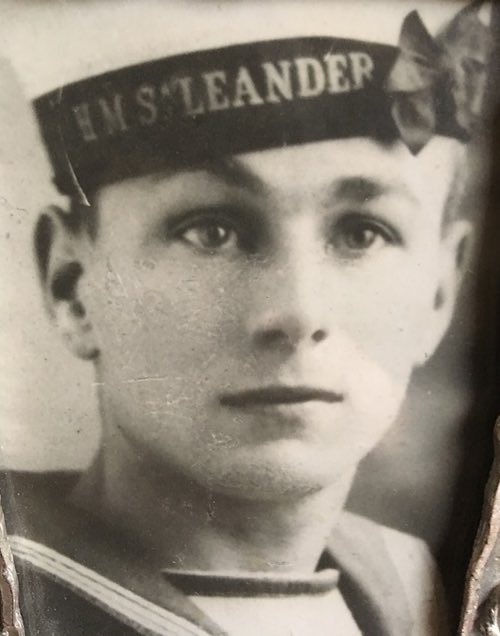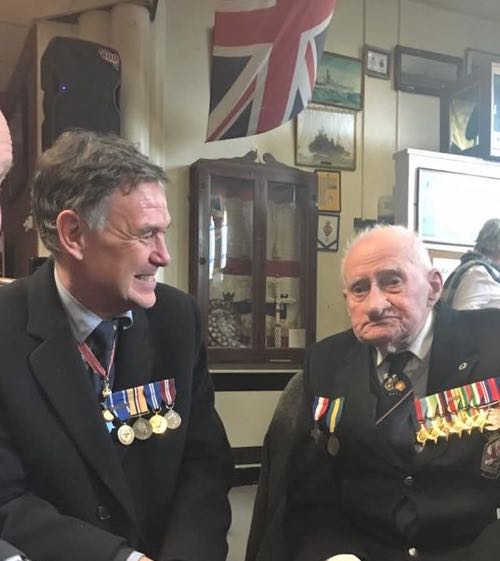
The Crew of HMS Exeter onboard at the Battle of the River Plate
Page updated 2nd May 2022
Return to People Lists

There is no definitive list of the crew of HMS Exeter, during the Battle of the River Plate in December 1939. This page is based on a list compiled by Jim Smith, who has kindly allowed its inclusion on Exeter Memories. The list now contains 486 crew names, with additions added by family and friends, and research in various newspaper articles. The full complement for the Exeter was approximately 630. At the bottom of the list, are the names of the British Hospital, Buenos Aires nurses who attended the wounded in the Falklands.
If you can add a name to the list, or add some biographical details or correct an entry, please email me.
With thanks to the British Council and TIME/IMAGE for the use of the stills of the crew after the battle. The photos of the graves and the template courtesy of John T. Pitman.
Notes - Names in BOLD killed in action or ¤ decorated for services during the battle. The British Library Newspaper Archive was used for many biographical details.
Surname - Forename - Rank - Decoration
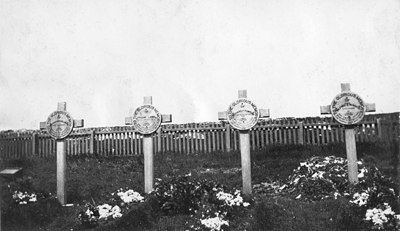
The graves of the four crew members
who were buried on the Falklands.
ABRAHAMS, Cyril, L Tel
ACKERMAN, R E, EA
ADAMS, Thomas W,
ADDYMAN A G, EA
AINGE Walter A, age 39, Chief
Petty Officer
ALDER G T C, LTO
ALLEN R H, Pay Lieutenant
ANNAL Thomas GeorgeThomas
George Annal - served on HMS Rodney until 1939, then HMS Exeter from
1939 and later on the Russian convoys - submitted by his grandson
James Thomas Annal., unknown
ANSTEAD C,
ARNOLD E, Royal Marines
ATTWOOD Harry, Sgt Royal Marines
ATWILL RonLieutenant Atwill wrote his account of the
Battle at
http://www.navyhistory.org.au/hms-exeter-at-the-battle-of-river-plate/.,
Lieutenant
AUKENHURST K, Royal Marines
AYRES J, Tel
The Falkland Islands News Weekly and Church Bulletin
Obituary
The most impressive ceremony ever witnessed in Stanley was seen on
Monday, December 18, when P0 Frank Legg and Chief P.0. Richard Powton,
members of the crew of HMS ‘Exeter’ who died of wounds from a Naval
Battle off the River Plate, were laid to rest in Stanley Cemetery with
full Naval Honours. The Funeral was attended by, His Excellency the
Governor and Commander in Chief, the Commander, Officers and men of HMS
“Exeter”, the Offices and a detachment of men from the Falkland Islands
Defence Force, and a large percentage of the general public. The service
in the Cathedral, conducted by the Rev. G.F. Grove, R.N. assisted by the
Rev. GK Lowe, was, in keeping with the spirit of the Navy and Church,
simple brief and dignified consisting of two Hymns, the usual lesson,
read by His Excellency the Governor, and the reading of the Roll of
Honour, the names of those who have died for God and their King and
Country. After the service the funeral cortege led by the Firing Party
with reversed arms, followed by the band, proceeded to the cemetery,
where the final prayers were said, three volleys were fired, the Last
Post and Reveille were sounded, and thus ended the simple but most
impressive ceremony of committing the souls of sixty-three brave men to
God. There were scores of wreaths from their shipmates and the general
public. Among the many floral tributes was a wreath from the Officers
and men of the SS “Karl Fritzen” bearing the following inscription “to
those brave men from HMS Exeter who died for their King and Country.”
BACK Frederick
Edwin ErnestERA Frederick Back was from Plymouth and aged 24. He
served as an apprenticeship boilermaker with Willoughby Ltd before
joining Exeter in 1937. His father had served in the Royal Navy for
24 years. He married in 1936 at St John's Church, Sutton-on-Plym to
Miss Blanche Brash. He had an 18 month old daughter, Barbara. He
lived at Beaumont Road, Plymouth. BLNA., Engine Room
Artificer 4th Class
BAGLEY Leonard C, Bandmaster 2 ¤ Mentioned in Despatches
BAKER Frank ReginaldLancashire Eveing Post.
"Three-Word Wire Brings Joy - A telegram of three words brought to a
Blackpool mother vesterdav, when Mrs. N. Baker, a widow, of
Devonshire-road, Blackpool received a reassuring message from her
son, Frank Reginald Baker, of H.M.S. Exeter, that he is safe. The
family, who until three weeks ago had lived in Lord-street.
Blackpool had heard nothing from him since the River Plate Battle.
The telegram said: 'Safe, well, love.'" LTO
BALL Alfred J,London Gazette – Alfred J. Ball, Able
Seaman; who when taken wounded to the Fore Medical Station himself
gave first aid to the other wounded and by his willingness and
cheerfulness was of great help to the Fore Medical Able
Seaman ¤DSM
BALLANCE J H, Lieutenant, Royal Navy Volunteer Reserve
BECKFORD W G, Wt Mech
BELL Frederick SeckerCaptain Bell was born in 1897. He
was educated at Matfield Grange, Kent and the Royal Naval Colleges
at Osborne and Dartmouth. He served at the Battle of Jutland and as
executive officer of HMS Repulse between 1935–38. He was promoted to
captain on 31 December 1938. He took command of HMS Exeter in August
1939. Bell was one of three officers to survive the hit on the
bridge, suffering minor injuries. He ordered the remaining undamaged
gun turrets to continue firing on the Graf Spee. Bell used a
lifeboat compass for navigation, and passed commands along a chain
of men to the lower steering compartment where there was a wheel
that was directly connected to the rudder. After Exeter’s guns had
been put out of action, Bell decided to ram with the enemy, saying
"I'm going to ram the --------. It will be the end of us but it will
sink him too". The Admiral Graf Spee turned to confront Achilles and
Ajax, and Exeter withdrew for repairs at the Falkland Islands.”.,
CAPTAIN ¤CB
BELL Stephen LeonardSeaman Bell was a torpedo man, who
was in A turret shell room during the action.Born 1920 died 2001,
aged 80, he served on HMS Hermione after the battle, before being
sunk in the Mediterranean by a torpedo. Left the Navy in 1948, to
join Cunard as a seaman., Seaman
BERNTSEN Ernest BasilTwenty
four year old Ernest Berntsen was one of at least two Falkland
Islanders serving on Exeter., Officers Steward
BEST JStoker Best was from Hull. On his return, in
March 1940, he became engaged. BLNA., Stoker
BETHELL Frank, age 19, Able Seaman
BETHELL Joseph, age 19, Able
Seaman
BEVIS VincentVincent
Bevis - lived in Bournemouth - named added by his great nephew Mark
Bevis, Stoker Petty Officer
BIDGOOD L, Supply
BLACKMAN R,
BLACKMORE C G,
BLAKE A B,
BLAKE JamesAble-Seaman
Blake was from Hilltown, Dundee. James Blake, who was 20 at the time
of the battle, had joined Exeter aged 15. He operated one of the 8
inch guns. He said "I was a good ducker and escaped without a
scratch. One chap who emerged from a door close by lost his life."
Next piece from the Dundee Courier "CITY LAD ON H.M.S. EXETER
Relatives in Dundee await news of James Blake (20), 249 Hilltown,
who is serving on H.M.S. Exeter, one of the cruisers which engaged
the Graf Spee... Son of Mr Charles Blake, shipwright, he entered a
naval training school five years ago on leaving Rockwell School.
Just before the outbreak of war James came home on leave, his first
visit in three years, but was recalled to his ship on the day he
reached home. A keen footballer in his schooldays, James was the
goalkeeper in H.M.S. Exeter's football eleven.",
Able-Seaman
BLANDFORD Bert, Royal Marines
BLEAKEN Royce DanielKnown as Dan Bleaken, he was 24
when on the ship at the battle.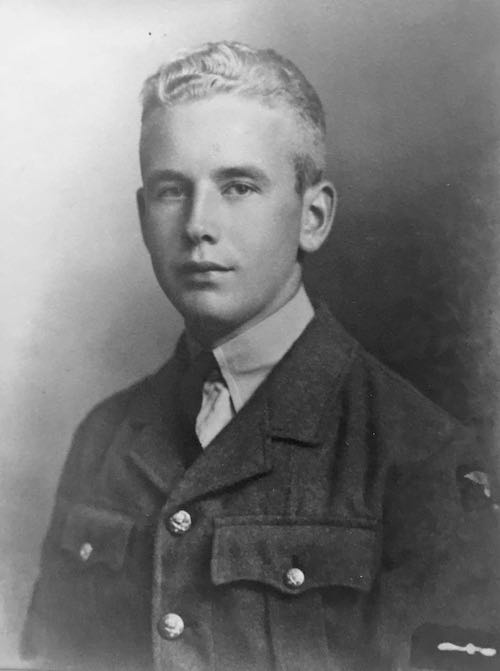 ,
mechanic Fleet Air Arm New
,
mechanic Fleet Air Arm New
BOILING R, ERA
BOND Frank L,London Gazette – Frank L. Bond, Engine
Room Artificer, Fourth Class; who, on a shell entering the Flat in
which he was, stood fast in the dense fumes, and, waiting until the
last man was reported clear of a Magazine, then flooded it. He then
went to the main centre of the fire to ascertain damage. He found
the flooding valve spindles shot away, the fire main shattered but
enough flow of water into the magazine from the damaged fire main.
So he carried on fighting the fire in the Chief Petty Officers'
Flat. After the action he performed his duties Engine
Room Artificer 4 ¤DSM
BONHAM Walter George HughLieut. Bonham worked on suppressing fires and assisted with the steering mechanism. In 1940, he commanded a small ship evacuating troops off the beaches at Dunkirk. He was killed in action in 1943. From the Cornishman ""I was in bed at the time, having come off the middle watch, and had only 20 minutes sleep, when somebody shook me and said that the order had been given for action stations to be taken. I thought somebody was playing a practical joke, and took no notice for a few minutes until your order came through on the ships broadcast. I immediately dressed and went to my station on the after control tower. The Ajax, Achilles and Exeter was steaming in line. The Ajax and Achilles veered to starboard and we went in the opposite direction. The Graf Spee was coming to meet us and it was not long before we were with him point blank range of her guns. She concentrated the majority of her fire on the Exeter as the biggest ship, and registered several hits. Very soon the first turret was shot away, and one by one each of the Exeter’s guns was put out of action, until there was not a single one left to return the pocket battleship’s fire. It was only then that the Esther was forced to drop out of the action-crippled and helpless-but the damage to German had been done, and the Exeter stayed long enough to see that her enemy was powerless to cause any more damage to other English vessels.”
,
Lieutenant Updated
BOWES Raymond M, Ordinary Seaman
BOOTHROYD RobertStoker Boothroyd was welcomed back, along with seven of his shipmates, to his home town of Birkenhead, by the Mayor, after they returned to the UK in February 1940. ,
Stoker Updated
BOWES Raymond M, Ordinary Seaman
BOWMAN-MANIFOLD JohnWestern Morning News "Lieut.-Com.
John Bowman-Manifold, who was killed in action at the battle of the
River Plate on December 13. was the navigating officer of H.M.S.
Exeter. Born at Winchester in 1909, he was younger son of Maj.-Gen.
Sir Graham Bowman- Manifold, of Heathcot. near Worplesdon Station.
Surrey, and grandson of Surg.- Gen. M. F. Manifold and of Adml. Sir
Thomas Brandreth, K.C.B. He entered Dartmouth as naval cadet in
September, 1922. passing out fourth in his term... Lieut.-Com.
Bowman-Manifold's duties in H.M.S. Exeter also included supervision
of the midshipmen and ship's boys, over whose welfare he took the
utmost pains. He qualified as an interpreter in French, and his
fluent Spanish enabled him to make friends among the naval officers
of the Spanish-speaking Republics. He appreciated to the full the
life in the Royal Navy, and by his death the Service has lost a
promising young man of much talent with many interests." ,
Lieutenant Commander (N)
BOWN E,
BRADBURY CharlesCharles Bradbury was mentioned in the
Nottingham Evening Post. "BAKEWELL HONOURS EXETER HERO. Standing in
the market square of his native town, Bakewell, yesterday,
Telegraphist Charles Bradbury, 20, of H.M.S. Exeter—one of the River
Plate victors received an inscribed gold watch from the townspeople.
His widowed mother watched the ceremony. Bradbury said: “if any of
you ask me what it was like then, I will only say one thing- good.
We waited three or four months for this final day, and when it
arrived we all cheered." BLNA.,, Telegraphist
BRADBURY W, Stoker
BRAY G,
BRIERLEY Frank, Chief Stoker D/KX 79771
BRIGHT Daniel, Stoker Petty
Officer
BRODERICK, ER, Able Seaman
BROOKS, Edwin
Alfred, ERA 3rd Class
BUCKLE, Musician Royal Marine Band
BUDD Albert SamualBudd was born in Exeter. He joined
the ship on 23rd December 1936 and left on the 28th February 1940.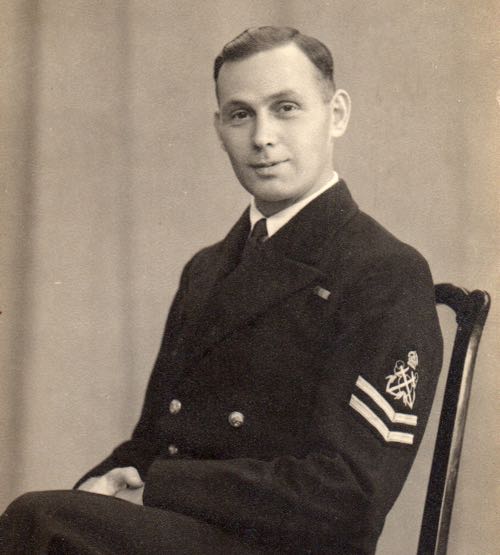 ,
Leading Signalman
,
Leading Signalman
BUDGE,
BURN S,
BURNS G,
BURNS R, Officers Steward
BURRAS Stanley W, Stoker First
Class
BUTCHER, Royal Marines
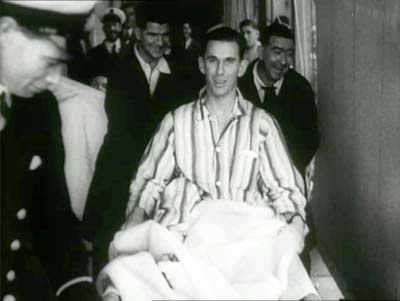
Sub-Lieutenant Causton with a broken leg

The graves on the Falklands of
Anthony C P Collings, Chief Shipwright
and Frank Legg, Petty Officer Cook
An extract from a personal account by Telegraphist Norman
Schofield of the burials at sea
Clearing up operations began and our dead were checked as 64—five died
afterwards on shore. The wounded were many and the wardroom was
converted into a Sickbay... All the dead were draped in blankets and
canvas and weights with chains etc. They were laid on the foc's'le and
quarterdeck and the burial at sea took place. Chums and buddies of three
years friendship were reverently committed to the deep in three minutes.
I think many of us who were watching had to quell the sickly lump, which
rose in our throats as their remains hit the water and sank. Everyone
was given a tot of rum; an old naval custom. It was new to me, and my
brother received half of my ration.
CALLEJA HugoHugo Calleja
- from Malta, he served as a Petty Officer/cook. He was also on
board in March 1942 - submitted by his grandaughter Charlotte
Lanfranco., Petty Officer/Cook
CAME Charles He joined the Royal Navy as a boy sailor and would have been a very young man at the time the battle. Later in life he was a Chief Petty Officer working as a schools liaison officer for cadets in the early 1980’s. He was bedecked with medal ribbons and was a real old salt., Seaman Gunner
CAMERON ArchibaldLondon GAzette - Midshipman Archibald
Cameron, Royal Navy, H.M.S. Exeter; who, when an 11-inch shell burst
above an ammunition locker and set it alight, with great calmness
and foresight ordered two guns' crews to take shelter. The locker
exploded, wounding some of the second crew and setting alight
another locker. As soon as the main fire abated, with the help of an
Able Seaman, he smothered the flames of the burning woodwork. The
two of them then threw the unexploded shells over the side. These
were still hot and the brass cartridge cases were either missing or
split open. The bottom row of ammunition had not burned, and this
also was thrown over the side. Throughout the action he showed the
utmost coolness and resource. He never failed to make the best use
of his guns' crews., Midshipman ¤DSC
CAMPBELL Frederick P, Stoker 1
CARTER Albert HExeter and Plymouth Gazette "Among
those board HMS Exeter at the Battle of the River Plate was Seaman
Gunner Albert H. Carter, old boy of Ladysmith-road School, Exeter,
whose father and mother live at 46, Stuart-road Heavitree, Exeter.
Albert Carter left school in 1929 and joined the Navy about five and
half years ago. Before joining the Exeter three years ago this
month, he served on HMS Furious. On HMS Exeter he took part in the
rescue work during the Chilean earthquake some time ago, and was one
of those who helped to quell the riots at Trinidad and made a trip
the New York's World Fair.", Seaman Gunner
CARTER Sidney A,London Gazette – Sidney A. Carter,
Master-at-Arms; who, though wounded in the right knee and severely
bruised by a splinter early in the action, carried on tirelessly and
devotedly Master-At-Arms ¤DSM
CARTTES S,
CAULDWELL R,
CAUSTON Jack Edward, Probationary Paymaster Sub Lieutenant, RNVR
(pictured right)
CHALKLEY Herbert V,London Gazette – Herbert V.
Chalkley, Acting Petty Officer; who, shortly after an eleven-inch
shell burst in the Chief Petty Officers' Flat above the dynamo room
in which he was, managed to open the door in the escape truck and
crawl over the wreckage to the switchboard hatch. He could not clear
the wreckage away, and realising that his services could be
dispensed with in the dynamo room, he scrambled up the dynamo escape
trunk to the upper deck, returned to the flat and helped the fire
parties in getting the fire under control and isolated circuits
there. The conditions in these two flats were very bad at the time
that he was trying to escape from the dynamo room. His work with
Acting Petty Officer ¤DSM
CHANDLER R, ERA
CHAPMAN T Cd Eng
CHEDGEY G LTO
CHEESEMAN,
CLARKE George C Royal Marines
CLARKSON Richard Mortimer Roy,
age 18, Able Seaman
CLIFT MWM, EA
CLOAKE J,
CODMAN RW, Able Seaman
COLLARD WilliamWilliam
Collard - Chief Petty Officer served on Exeter during the South
American cruise before war broke out. Sunmitted by his
great-grandaughter Yvonne Helicon. Western Daily Press - "Tuesday 23
April 1940 WHALE FOR MUSEUM? PETTY OFFICER W. COLLARD, of
Weston-super-Mare, who was on the HMS Exeter in the River Plate
battle, has made the novel gift, of a bottled embryo whale to the
Weston Museum. He procured the whale at the whaling station in South
Georgia. It was with his possessions on H.M.S. Exeter during the
River Plate episode." , Chief Petty Officer
COLLIER, Musician Royal Marines Band
COLLINS Anthony C PAnthony Collings
was badly burned when a shell burst in the Chief Petty Officers'
Flat. He carried on supervising repair work until he fell
unconscious. He later died of pneumonia in the hospital at Port
Stanley on the 23rd December and was buried in Falklands (see
photo). He was from Millbrook, and married with a son. His parents
were from Island House, Millbrook. BLNA., Chief
Shipwright 2 ¤ Mentioned in Despatches
COMLEY WilliamWilliam Comley was a regular Royal
Marine. He was in the gun turret that was manned by the Royal
Marines. When it was hit he was pulled out on fire. He operated the
"range finder" which was a big piece of equipment & he said that
is what saved his life. He ended up in hospital in the Falkland
Islands., Royal Marines
CONYON J, Petty Officer, Gun Layer Armourer
CONNOR F, Royal Marines
CONNOR Horace ArolHorace Arrol Connor - service number
D/JX 149298 - survived the Battle but sadly not the war. There is a
photo of Horace pointing to damage on the funnel of HMS Exeter after
the encounter with the Graf Spee. He was in the parade in London
after the battle. Horace was killed when he was torpedoed in the
Mediterranean whilst serving on HMS Bonaventure. Details added by
his stepbrother Donald Connor., Signalman
COOK A E, Dir Gnr
COOPER Horace Samuel, Able Seaman
CORMACK John TJohn T
Cormack - Stoker, Petty Officer, his number was DK/X.92237. He died
in Australia in1973 - submitted by his daughter, Helen Cormack. ,
Stoker Petty Officer
COWANS, ERA
CRAGG George RobertNottingham Evening Post - 18
October 1940. "Seaman Cragg was on HMS. Exeter when it took part in
the Battle of the River Plate, and since then had been transferred
to HMS Ajax, whose notable achievements last week in sinking two
Italian destroyers and crippling a third, is described one of the
finest naval feats of the war." BLNA.
CRITCHLEY M,
CROCKER George I, Chief Stoker ¤ Mentioned in Despatches
CROKER Alfred John, age 25,
Marine Royal Marines
CROSS Victor"Served on
her prior to and during early part of WW2, he was an Able Bodied
Seaman at the time of the Battle of the River Plate against the Graf
Spee. Thought likely to have been on the 4.5 inch guns during the
battle (but not certain). I have his Royal Navy book covering the
cruise of HMS Exeter of South America, from 1936 to 1939 just before
the battle. Victor was married to Violet Pickton (nee Vinant) on the
14th August 1948 in his uniform. Discharged from the Navy dead on
23rd September 1948. He was killed as a result of a Gunnery accident
at Wembury. A shell had become stuck in the breach and blew up, with
the blast killing him. He died having had no children of his own.
Buried at Canford Cemetry Westbury On Trim." Colin Cross nephew.,
Able Bodied Seaman
CROWE Thomas H, Seaman
CROWLEY GeorgeNottingham Evening Post - 10 August 1940
"Chief Petty Officer George Crowley, of Plymouth, who was aboard
H.M.S. Exeter in the Battle of the Plate, was married this afternoon
at St. Andrew's Presbyterian Church, Belgrave-square, Nottingham,
the ceremony being conducted by the Rev. G. Walker. His bride was
Miss Florence Dver only daughter of Mr. and Mrs. H. Dyer, of 68
Chadwick-road, Nottingham." BLNA.
CURNOW Frances JohnFrom comments page "Frances John
Curnow was born on 28th august 1919, and passed away 14th February
1987. He served 22 years, until 1962. He was chief engine room
artificer - Captain Bell promoted him to Chief PO after the battle.
My father played rugby for Cornwall under 16, got his cap, was also
a champion wrestler, 4 years on the trot [Cornish] got his trophies,
plus photos, Lord and Lady St Leven on St Michael Mount presenting.,
Chief Engine Room Artificer
CUSSEN John, Surgeon Commander ¤ Mentioned in Despatches
DAKIN EricAberdeen Journal - 16 July 1940 "FROM
FALKLAND ISLES TO MARRY Miss Mary S. J. Miller, a nurse at King
Edward Memorial Hospital, Falkland Isles, has travelled ten thousand
miles to Leicester to make her home. She has become engaged to a
sick berth attendant, Eric Thomas Dakin, of Dronfield Street,
Leicester, who was awarded the D.S.M. for bravery on H.M.S. Exeter
in the River Plate battle. Miss Miller wos born on the isles, and
the couple first met in a hospital there." BLNA. London Gazette –
Eric T. Dakin, Sick Berth Attendant; who had been in the ship only a
week, having been lent from H.M.S. Ajax, his first ship. His conduct
throughout the action was exemplary. He carried out instructions
perfectly, his first-aid treatment was very good and his quiet
gentle manner gave great confidence to the wounded. His ability to
take charge and keep order in difficulties was splendid.,
¤DSM
DALLAS-SMITH Peter, Midshipman
DALLAWAY Stanley J, Gnr ¤ Mentioned in Despatches
DANCE S T, Musician Royal Marines Band
DANN H, Sub Lieutenant, Royal Navy Volunteer Reserve
DAVEY A,
DAVIES F,
DAVIES Gilbert L, Able Seaman
DAVIES Stanley, Able Seaman
DAY E, Seaman
DAY H, Seaman
DEVINE Richard VictorFrom
Liverpool, he was 21 at the time of the battle. His parents were Mr
and Mrs Robert Devine of Bran-street, Dingle near Liverpool. He was
probably an Able-Seaman., signalman
DINGLE K,
DOUGLAS-DON Robert W DRobert
Don was from Cheltenham. BLNA. London Gazette – Midshipman Robert W.
D. Don, Royal Navy; who, throughout the action showed great calm,
resource and initiative, especially in running hoses into the
burning Marines' barracks, in fighting a fire over the lower
steering position, and in rescuing the wounded.
Dundee Courier - 10 February 1940 IN EXETER THEN AJAX
On a flying visit to Angus this week was Acting Sub-Lieutenant
ROBERT WILLIAM DOUGLAS-DON, son of Captain Douglas-Don, of
Maulesden, Brechin, and of Mrs Baxter, of Invereighty.
Sub-Lieutenant Douglas-Don was midshipman in H.M.S. Exeter, and took
part in the battle which sealed the fate of the Graf Spee. Educated
at Cheltenham, he underwent his cadet training at Portsmouth,
following which he was on two voyages of about three months each in
H.M.S. Vindictive. In May 1937 he was appointed midshipman in the
Exeter. Following the defeat of the Graf Spee he came home on H.M.S.
Ajax, and, after a few days in London, came north. He returned last
night to England to undergo his qualifying course as a lieutenant.,
Mentoned in Despatchess ¤DSO
DOVE Gilbert H, Acting Petty Office
DOUST Ernest A, Snr Master ¤ Mentioned in Despatches
DRAKE,
DURHAM R , Seaman
DYER Frederick W GWestern Morning
News "Before joining the Navy he served his apprenticeship in
Devonport Dockyard. Then, like his father, he decided to go to sea.
Mr. Dyer's parents live at 11, Phillimore - street. Devonport".
Express and Echo "... who was a well known figure in Devon Rugby
circles a decade ago. A Plymouth Albion stalwart, he was a fine
full-back and centre-threequarters, and played for Devon County for
two seasons, his last game being against Cornwall. In this he was
badly hurt, and was forced to retire.", Shipwright 3
EARP H,
EAST R D, MA Tempy. Instr Lieutenant
EDDEY W, EA
EDMONDS, Norman, Able Seaman
EDNEY Ivor HaroldLeading stoker Edney crossed the line
on Exeter on the 11 January 1937. After the battle, Exeter, badly
damaged, limped into St. Georges on the Falkland Islands. He was one
of the crew who used sheets from the Whaling Sheds for repairs. He
was born on the 13th of February 1910, at Penryn, Cornwall, after
the War he settled in Kiddiminster., Leading Stoker
EDWARDS ArthurArthur Edwards had been in the Navy for
fourteen years at the time of the battle, when he was in the Fire
and Repair Party. He lived at Pinkerton Place, Rosyth. (BLNA),
Petty
EDWARDS, Royal Marines
EMBLETON Chas James, Stoker
EMMETT Stephen AnthonySteven
Anthony Emmett - he was also in the crew when Exeter was sunk on the
2nd March 1942 and held as a Japanese POW. Name added by his son
Mark Hernandez., Stoker
ENGLAND Philip A, EA 1 ¤ Mentioned in Despatches
ENNIS Ivor JohnIvor John ENNIS, who was 20 years in
1939, had been on the ship during the Chilean earthquake, and for
which was awarded a non-commissioned rank award. ,
Stoker New
EVAN George AlwinSeaman, in Y Turret shell room during
the battle. From West Corby on the Wirral, he was the brother in law
of Seaman Stephen L Bell, who was also on the Exeter during the
battle. He served on HMS Banaventure after he left the Exeter, when
she was sunk. After the war he worked for the Mersey Docks and
Harbour Board, and died in the early 1970s., Seaman
EVANS David GwynDavid Gwyn Evans joined the Royal Navy in 1926 as a boy sailor. During the battle he was in the blacksmith’s shop. He gave two interviews to mark the 50th anniversary, one to RTE and another to the Imperial War Museum. , Able SeamanNew
EVANS R
FLETCHER FrederickFrederick
Fletcher was one of the crew manning a gun turret in which six were
killed. He was 19 years old, and from Admiralty Road, Rosyth. (BLNA),
Royal Marines
FARTHING F CF C Farthing was from Burnham-on-Sea in
Somerset. Western Daily Press "THE battle of the River Plate was
thrillingly recounted to a packed audience at the BURNHAM-ON-SEA
Town Hall, when a presentation was made to Mr F. C. Farthing.
Burnham's sole representative on H.M.S. Exeter." BLNA.,
LTO
FLOWERS W, Seaman
FOGWILL Reginald Albert, Seaman
FORBES Alexander S, Boy 1st Class
FOWLER George CW, Lieutenant Cdr (O)
FOX George Cyril, Petty Officer
FRANCIS H W, Seaman
FREDERICKS J TSeaman Fredericks was
20 years old at the battle. He sustained a shrapnel wound in his
head, from which he died in Buenes Aires on 14 March 1940. BLNA.,
Seaman
FREEMAM Peter JamesGunner Freeman was born in
Liverpool on the 27th January 1920, joining HMS Ganges as a Boy
Sailor on the 9th July 1935 aged 15. After a brief stint at HMS
Drake and then 'Queen Elizabeth' he was posted to HMS Exeter on 7th
June 1936 where he served until 11th July 1940. He later served on
HMS Kenya with action supporting the Vaasgo raid in Norway and the
onerous Malta Convoys, Operations Halberd and Harpoon as well as
Pedestal where the Kenya received severe damage from a torpedo. He
saw action in the Norwegian Sea escorting convoys to Murmansk. He
represented Devonport in the Field Gun Crew in 1947.,
Gunner (AB)
FRENCH Frederick T, Able Seaman
FRENCH, Boy
FROST L GAble-Seaman Frost received shrapnel wounds
during the battle. Western Morning News "L. G. Frost, one of the
crew of H.M.S. Exeter engaged in the battle of the River Plate, was
presented with an inscribed Bible and cigarettes by the Mayor (Mr.
J. Lewis). Making the presentation, the Mayor said: "Tiverton is
proud of you." ...Congratulating Able-Smn. Frost on the way he and
his comrades had played their part upholding the great traditions of
Britain, the Mayor remarked: "No matter what great battles take
place in the future, whether on sea, land, or in the I air, Tiverton
is more sure than not to have one or more of its sons taking part."
BLNA., Able-Seaman
FULLERTON Roy GRoy G
Fullerton - joined Exeter for the 1936 South American cruise. He was
presented with a medal by his home town, Alloa, Scotland after the
battle. He died in 1988. Name added by his son Bert Fullerton.
, age 29, Able-Seaman.
FUTCHER, Tel
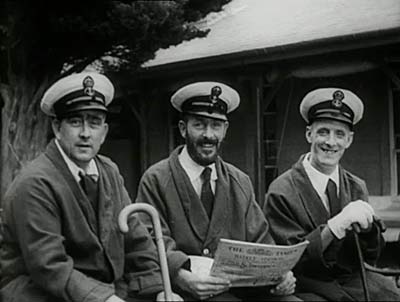 CPO Willie Claude Truman, PO Nemo of HMS Ajax and PO J Green of the
Exeter, in Capetown.
CPO Willie Claude Truman, PO Nemo of HMS Ajax and PO J Green of the
Exeter, in Capetown.
GARDNER LH, Corporal Royal Marines Band
GARRARD J S,
GARRETT V,
GASKELL J L, Ck
GEORGE Evan I, Leading Stoker -
died 15th December
GIBSON Stanley C, Able Seaman
GIBSON, Musician Royal Marines Band
GILPIN L, Ck
GLEADELL OwenStoker
Gleadell was one of at least two men from the Falkland Islands,
serving on Exeter. BLNA., Stoker
GLOVER Kenneth EdgarExeter and Plymouth Gazette - 24
May 1940 "... Boy Kenneth Glover, one of the Exeter heroes of H.M.S.
Exeter's famous encounter with the Graf Spec, visited Exeter
Guildhall on Saturday, and was welcomed the Mayor and Mayoress ...
and the Sheriff ... . Still carrying his left arm in a sling, he was
accompanied by his father and mother, Mr. and Mrs. N. T. Glover, of
63. Shakespeare-road, and his six-year old brother, James. With the
Mayoress was Mrs. Oakley, of 54a St. Leonard's road, Exeter, cousin
of Lt.-Comdr. J. Bowman-Manifold, navigator of H.M.S. Exeter, who
had charge of the midshipmen and boys on the ship, and who was
killed in the action the River Plate. Boy Glover is on leave from
hospital, to which he is to return shortly for a grafting operation
to his injured arm. The civic heads were intensely interested in the
reminiscences related by young Glover..." Boy Glover attended
Bradley Rowe School, leaving in 1936. BLNA., boy 1st
class
GOODE T, EA
GOODHALL F, Tel
GOODWIN Horace (Harry)Horace
Goodwin - Stoker, First Class NoKX92154 Served 21st April 1938 to
29th Feb 1940 - submitted by his son Roy Goodwin., Stoker
First Class
GOURD C, Chief Petty Officer Wtr
GRAHAM R,
GRAHAM Robert RCommander
Robert Graham suffered a shrapnel injury during the battle.
Nottingham Evening PostMay 1940 "EXETER HERO KILLED IN ACTION.
COMMANDER GRAHAM. Commander Robert Rule Graham, who won the D.S.O.
in H.M.S. Exeter during its fight with the Graf Spec, was killed in
action on May 3rd, while in the French destroyer Bison. In the
"London Gazette" notice of the D.S.O. award, it was stated that when
the day for action came he heartened all by his readiness, example
and encouragement." In the battle he received more than a dozen
shrapnel wounds.", Commander, Companion of the
Distinguished Service Order.
GREEN JamesHaving evacuated the wheelhouse, PO Jimmy
Green suffered very bad burns when a shell exploded between the ERA
and Petty Officers' messes., Petty Officer - Chief
Quartermaster
GREEN William E,London Gazette – William E. Green,
Petty Officer; who, as Chief Quartermaster, when the upper steering
position was put out of action by an 11-inch shell exploding on a
Turret ensured that the secondary steering position was correct and
fully manned. Finding it to be so he started aft to see that the
after steering position also was correct; on his way he was
seriously wounded. REPORTED WOUNDED ON H.M.S. "EXETER" BIDEFORD
PETTY OFFICER Among those reported wounded on H.M.S. "Exeter" in the
outstandingly successful naval battle of three British cruisers
against the German "pocket" battleship "Admiral Graf Spec," in which
the "Exeter" played such a gallant part, is Petty Officer W. E.
Green, of Florencia, Clovelly Road, Bideford, and son-in-law of Mr.
and Mrs. John Headon, of Sunny Dale, Clovelly. Mrs. Green is now
staying with her parents at Clovelly. Before making their home at
Bideford, P.O. and Mrs. Green, who were married about nine years
ago, lived at Clovelly. They have many friends in both places, who
with relatives, last week anxiously awaited further news as to the
extent of his injuries. Coming from a Portsmouth Naval family, P.O.
Green has nearly completed his time in the senior service, being due
in the normal course of events for retirement. In the last war he
was wounded at the age of fifteen. Chief Quarter Master
¤DSM
GREEN L, Seaman
GROVE George FrederickNAME OF 'EXETER' GIVEN TO BABY
Christening In Famous Cruiser At Plymouth NAMES of Barry John Exeter
were given to the 18-months-old son of Warr.-Eng. J. J. Tayler when
he was christened in H.M.S. Exeter at Plymouth yesterday. The ship's
bell, inverted and resting in a lifebuoy which bore the ship's name,
was used as the font, and Capt. F. S. Bell, captain of the Exeter,
was godfather. The ceremony was performed in the captain's lobby by
the ship's padre. Rev. G F. Grove, the presence of
officers, officers' wives, and the ship's company. Mrs. Tayler had
journeyed from Portsmouth with her baby son to meet her husband when
the Exeter arrived at Plymouth. Unaware that he was in surroundings
now famous in naval history, the baby cried lustily during the
christening ceremony. , Ship's Chaplain
GWILLIAM W GLondon Gazette – William G. Gwilliam, Able
Seaman, H.M.S. Exeter; who helped Midshipman Cameron to smother the
flames of a burning ammunition locker, and to throw hot shells, with
their brass cases either missing or split open, over the side. He
showed no regard for his own safety in putting out fires–on the
Upper Deck near the aircraft from which petrol was leaking.,Seaman
¤CGM
HALLAS Charles F,London
Gazette – Charles F. Hallas, Petty Officer; who was the Torpedo
Gunner's Mate in charge of the torpedo tubes. Although wounded at
the start of the action he remained at his station until all
torpedoes were fired. He then formed parties to deal with fires on
deck and help the wounded. After the action he worked unceasingly in
repairing damaged circuits. His cheerfulness throughout was a great
encouragement to all who were working with him. Petty
Officer ¤DSM
HALLIDAY Leonard FrancisWritten by his son in law
"During the Battle of the River Plate Len was in Y battery...
usually referred to as "Lazy Y" because during nearly every gun
practice Y battery used to break down. They knew the Exeter was
being hit and the first impact on Y battery was they lost the
external fire control. Having been in the navy a long time, starting
at Greenwich college, Len was a very experienced gunner so they
continued firing using "line of sight". They were getting better
results this way, and were scoring more hits. The turret took a hit
and they lost one gun and all the hydraulics. They then had to carry
the shells up from the magazine by hand and do everything else
manually. I think Len said that they emptied the magazine but I am
not certain about this.
HAMBLIN Victor A, Seaman
HARDING, Royal Marines
HARRINGTON Stanley P, Marine
Royal Marines
HARRIS C,
HARRIS David, Stoker PO
HARRIS HughWestern Morning News
"H.M.S. EXETER HERO Newquay Man One Of Victims In Graf Spec Action
Official confirmation has been received at his home, 31, St.
Georges-road, Newquay, that P.O. Teleg. Hugh Harris was killed while
serving H.M.S Exeter during the action with the German battleship
Graf Spec. Mr. Harris, single man, aged 39 years, served in the last
war, and was present at the Battle of Jutland, being then 15 ½ years
of age. Prior to joining the Navy he was a member of Newquay branch
of the Sea Scouts. P.O. Harris was the second son of the late Mr
Adolphus Harris, and has served in the Royal Navy for the past 22
years, being due for retirement on pension this Christmas. He was a
very jovial disposition, and much sympathy is expressed in Newquay
for his relative", Petty Officer Telegraphist
HARRISON TysonNorthern Daily Mail "Stoker Petty
Officer John Tyson Harrison of H.M.S. Exeter, whose home address is
21 Winterbottom Avenue, West View, Hartlepool offered me his
cigarette case and remarked “I’m afraid I can't tell you very much.”
But it was not an ordinary cigarette case writes a "Northern Daily
Mail" reporter. Of leather, it carried a crest embossed in gold.
This cigarette case—a replica of which was presented to each man of
the Exeter at the Lord Mayors banquet—and a few fragments of Nazi
shrapnel are his only tangible reminders are one of the greatest
incidents in British naval history—the battle of the River Plate.
Hartlepool's representative—incidentally, you are sure to find the
Hartlepools represented on most of our ships—is home again. Petty
Officer Harrison had five days leave in August, and then the crisis
called hurriedly back to the ship. "Action stations." Harrison, In
the depths of the ship heard the first details of the challenge
through Exeter’s loud speakers from which instructions to the crew
went into action sailing at full speed.", Stoker Petty
Officer
HARRIS S T, Sig
HASKIN WilliamStoker Haskin served on HMS Exeter from
8th December 1936 to 1940. He joined H.M.S.Drake on 1 March 1940. KX
80007., Stoker 1
HATTON J,
HAUGHTON F, Chief Ordinance Artificer. Mentioned in Despatches
HAYLETT GeoffreyEngraved
watch given to Geoffrey Haylett after the battle. This is the only
evidence of Haylett being in the battle.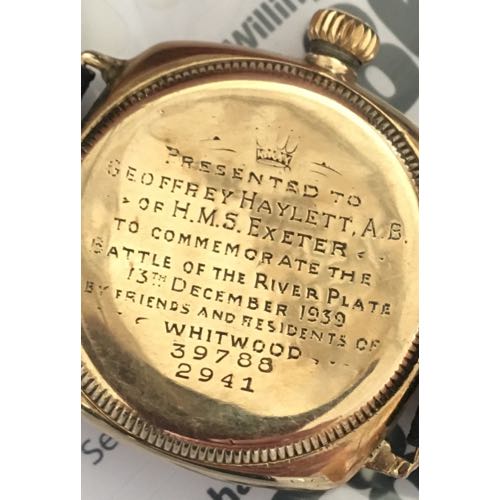 ,
AB
,
AB
HEARSON G, Cdr (E)
HEENAN Robert Lawrence, Lieutenant, Royal Navy Volunteer Reserve Met
HEGGIE R M, Surgeon Lieutenant, Royal Navy Volunteer Reserve
HICKS A, LSA
HIGGINBOTTOM Alan, Chief Yeoman
of Signals
HILL Leonard C, Able Seaman -
died from wounds 14th December 1939
HILL RichardRichard Hill was 19, and had been on
Exeter for two years. He was from Dowell Street Honiton, Devon. When
the order "Action stations" was sounded he was in his hammock,
having been on duty the previous night. During the battle shrapnel
hit his locker, ruining some of its contents. His relief look-out,
Ernest Basil Squire, was killed in the engagement. BLNA.,
Gunner
HILL Ronald B, Boy Bugler RM
HINDLE F,
HOARE D J,
HOARE E,
HOCKINGS Henry Herbert"Our father served on HMS Exeter
from 14 December 1936 to 27 February 1940, which included the South
American Tour of Duty and The Battle of the River Plate. During the
latter he was one of 15 Royal Marines manning the Forward B Turret.
We have in our possession a solid cast handle with 'OPEN FIRST SHUT
LAST' engraved on it and badly twisted from shellfire..from B Turret
maybe? I remember being told it saved my father's life as he was
holding on to it when they got hit... He was a keen sportsman and
partook in boxing, rugby,tug of war, polo and swimming teams. Sadly
he died in Exmouth at the age of 53." Name added by his daughter Mrs
P Packer., Corporal Royal Marines, from Exmouth
HOGG Donald, Stoker
HOLMES Charles Edwin"Stoker Charlie, as he was known,
spent 16 hours in the stokehold before the lighting failed. On the
16 February 1940, the Daily Sketch published his poem about the
battle.
‘You’ve heard of Britain’s heroes bold in air, on land or sea.
But here’s a tale will ‘ere be told, the fate of the Admiral Spee.
The 13th of December was her unlucky day.
’Twas then she met the Exeter hard by the River Plate.
And tho’ she was the stronger in armaments indeed.
We’d speed aboard the Exeter and men of bulldog breed.
We met as dawn was breaking. She raked us with her shell.
But we put trust in the turbine’s thrust, and our faith in Captain
Bell.
Tho’ many of our comrades fell even at victory’s gate.
Theirs was the death of heroes, her’s an inglorious fate.
Sunk by her captain’s orders, a woeful sight to see.
No more shall ride Germania’s pride, the Admiral Graf Spee.’",
Petty Officer Stoker
HONEY Leslie F L, Leading
Signalman
HORSLEY W, unknown
HOWARD Horace, Stoker
HOWELL Bernard L, Photographer
HUXSON, Royal Marines
HUNT, Royal Marines
HURLEY,
HUTTON J, Torpedoman
IVEY W G,
JACKSON E, Corporal Royal Marines Band -
met girl in Falklands after the Battle and married her.
JAMES Thomas L, Steward
JAMIESON, Percy, Musician Royal Marines Band
JANES , Charles,J.23732, Petty Officer Janes, joined
HMS Exeter, from HMS Ajax on 2 December, 1939 and left her on 19
February, 1940. He was awarded the Wounds & Hurts Certificate
for "wounds received in action." Petty Officer
JEFFERIES James Emmanuel,Joined as a Boy 1st Class in
October 1934. Discharged from Exeter on 29 February 1940. Crossed
the line on Exeter on 11 January 1937. Discharged from RN August
1948 as not fit for service. Able Seaman
JEFFERY W,
JEFFERY W J, Seaman
JEFFREY A D, OA
JENNINGS Richard B,London Gazette – Commander Richard
B. Jennings, Royal Navy; who throughout the action controlled the
main armament with great calmness and skill. When only one Turret
was left in action he tried to spot from the after control position
though standing over the muzzles of the guns. Throughout and after
the battle he was untiring in his work of keeping the turret in
action and in directing the ship's company to clear away the debris,
the Commander being wounded. Lieutenant Commander (G)
¤DSC
JOHN James Edward L, WO Gunner
JOHN Henry B, MBE Pay Cdr ¤ Mentioned in Despatches
JOHNS R,
JOHNS William, E Ch OA 1 ¤ Mentioned in Despatches
JOHNSON Leslie Robert, Royal Marine
JOLLIFFE CharlesCharles
Jolliffe - he served on HMS Diomede after he returned to England
after the battle. Submitted by his grandson Rich Harvey.
JONES Albert S, Stoker Petty
Officer ¤ Mentioned in Despatches
JONES C J, Seaman
JONES EdwardEdward Jones
- lives in Adelaide, Australia (2009) - name added by Bill Hartland
(Ted), Musician Royal Marines Band
JONES J H, Royal Marines
JONES R M, Rev
JOPLIN Walter, Stoker
KAVANAGH Michael T, Telegraphist
KEELING J HJ H Keeling
lived in Westgate Street, Gloucester. Along was Able-Seaman Powell,
he was greeted by the Mayor on his return. BLNA.,
Able-Seaman
KELLY Albert E, Stoker 1
KEMBALL H N EH. N. E. Kemball. R.N., was the second
son of Col. H. F. Kemball, D.L., of Newlands, Ingatestone near
Chelmsford., Lieutenant
KENT W H, Royal Marines
KENWARD, Musician Royal Marines Band
KING D,
KNIGHT Frederick,London Gazette – Frederick Knight,
Joiner (Third Class); who, while bleeding in the face and badly
shaken by the 11-inch shells exploding on the forecastle Messdeck,
used great initiative in improvising stretchers for the wounded, in
examining compartments underneath the damage and in plugging holes
in the upper deck. ¤DSM

Stoker Lewis with a broken neck after the battle.
LAMB Geoffrey Silverwood"I
am writing as my grandfather served on HMS Exeter during the Battle
of the River Plate. He was a pilot and officer and his name was
Geoffrey Silverwood Lamb. After returning to the UK, he was
invalided out of the Navy as he suffered from trauma. We believe he
was re-assigned to test Spitfires at Southampton Eastleigh airfield.
Here he and his engineer were killed on 1st July 1942 when their
Spitfire crashed into a pylon or tall structure. Allegedly, he had
frequently spoken about the probability of this occurring when a
certain cross-wind was blowing." Rosemary Greenfield (nee Lamb),
Lieutenant (Pilot)
LANCASHIRE Roger W G,London Gazette –
Surgeon-Lieutenant Roger W. G. Lancashire, Royal Navy; who, during
the action and throughout the passage to the Falklands, with no
sleep, worked cheerfully and unceasingly in tending the wounded.
Surgeon Lieutenant ¤DSC
LANGMEAD E,
LANSDOWNE Cyril, H L Tel, Mentioned in Despatches
LEGG FrankPetty Officer Legg died
16th December and was buried on the Falklands. (see photo) BLNA.,
Petty Officer Cook
LAXTON Reginald James, Able Seaman
LEWIS C G,
LEWIS D S G, Stoker 1 (pictured right with broken neck)
LISTER AndrewMarine Andrew Lister sustained a
laceration to the lower third of his right leg , and a shrapnel
wound to his head, during the battle. He served on the Exeter
between 3 September 1939 and 27 February 1940. He later served on
HMS Repulse, HMS Caradoc, and HMS Duke of York.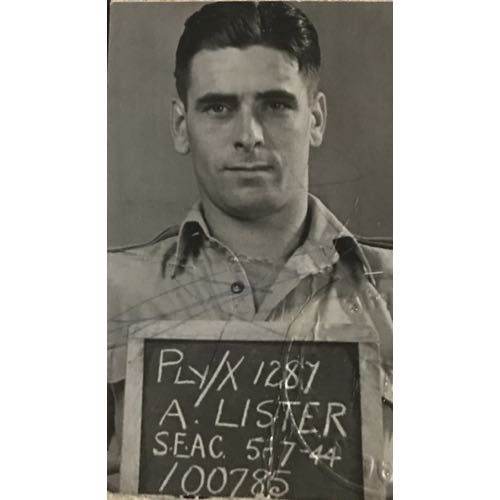 ,
Marine New
,
Marine New
LLEWELLYN,
LOCKER G,
MACLEOD
William, age 25, Stoker 1st Class
MACNAMARA W,
MAGEE (McGee?), Musician Royal Marines Band
MAKIN JamesJames Makin -
he served on the 1936/39 South American Cruise through to the
sinking in March 1942, and then held in a Japanese POW camp.
Submitted by James Oldfield-Williams., Able Seaman
MANNING GeorgeWestern Morning News
"LOST IN H.M.S. EXETER. Totnes Man Among Those Killed First Class
Sto. George Manning, of Landscove, near Totnes, was one of those
killed in H M.S Exeter in the battle with the Graf Spee. He leaves a
widow to mourn his loss... he was one a family of ten children. Mr.
ana Mrs. Manning had had their home at Plymouth for many years. Mr.
Manning only enjoyed hours' leave after a three-years commission on
the West Indies Station before being recalled. He had only eighteen
months to serve for his pension. " , age 37, Stoker 1st
Class
MANSON TomTom Manson -
from South Shields, he was a Royal Marine Corporal who served on
Exeter between 24th September 1938 to 14th March 1940, on gunnery
station during the battle - submitted by his son Ray Manson.,
Corporal Royal Marines
MARSH William George Robert, age
21, Corporal Royal Marines
MARSHALL A S, Signaller
MARSHALL A SBrother of Stanley Marshall, below, he was
given a message to deliver to the bridge wireless office, just
before the bridge was hit, where several were kiled.,
Marine
MARSHALL StanleyDaily Mirror - 2 January 1940 FAMILY
IN THE NAVY JUSTLY proud of their family record service in the Navy
and Marines are the Marshalls, of Spencer-avenue. Exeter. Mr. W. E.
Marshall has been called up for service in the Marines, in which he
served twenty-one years... and his second son, Stanley, is in H.M.S.
Exeter. No news has been heard of him since the sinking the Graf
Spee, so the family presume he is safe. , Marine
MARTIN R B Commander (Staff Officer)
MASON,
MATHER James, Seaman
McAUSLAN,
McBARNET Donald TMarried
February 1940 at Antony House, Torpoint. The bride was given away by
Captain Bell., Lieutenant RN ¤ Mentioned in Despatches
McCORMACK Alfred JamesGunner James McCormack,
SSX22762, was from Middlesbrough. He joined the navy age 16 in 1934.
He married on 16 March 1940, just two weeks after arriving back in
England after the battle. He died in 1989.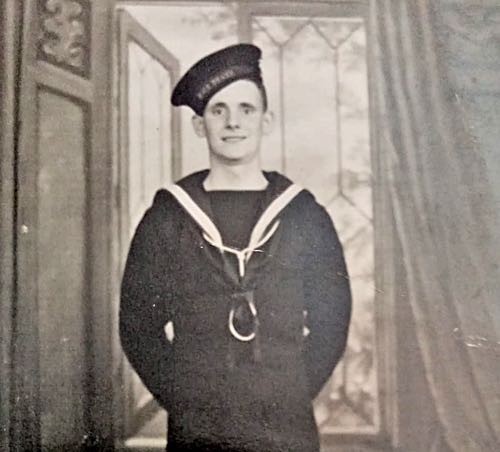 ,
Gunner
,
Gunner
McDONNELL Francis, H Able Seaman
McEVOY James P, Marine Royal
Marines
McGARRY James,London Gazette – James McGarry, Engine
Room Artificer, Second Class; who on his own initiative at the
beginning of the action flooded the petrol compartment. After the
two shell bursts near him and in dense fumes, with dead and dying
around him, himself blown against a bulkhead and temporarily
stunned, he maintained complete charge. He got Shipwrights to
investigate damage and organised stretcher parties and the work in
his area. On the arrival of'the Engineer Officer he made a complete
report while a messenger supported him. Engine Room
Artificer 2 ¤DSM
McGEE W,
McGINN Jock,
MCGREGORNothing more is known about this member of the
crew apart from this tragic newspaper story. "FATHER'S DEATH TRAGIC
HOMECOMING FOR EXETER HERO A sad homecoming awaited son who went to
Perth, Western Australia, on convalescent leave after serving H.M.S.
Exeter in the River Plate battle. His proud father, Mr. Allan
McGregor, set out to cycle to Perth from a country district to meet
his son. A few days later the father was found on the road dead from
thirst, with an empty water-bottle beside him." BLNA.
MEDLEYExtract from a letter to a friend, sent on 15
February 1940, on the day Exeter returned to Devonport. "Well no
doubt you will know that today is a very happy & busy day for us
as we arrived home in Eng after out dangerous twenty-five day
voyage, (with all Hitlers navy looking for us through sinking the
Graph Spee) well I am afraid he was foiled once again, &
sometimes I wish we had met another & we would send that to
'Davy Jones' also... We are all absolutely worn out after our task
of getting the ship sea worthy & home. I only wish that you
could see the poor old Exeter now, with her masts half shot away
& several patches in the side, the funnels with at least a dozen
holes in and two boats missing, believe me you would not recognise
it... this war is affecting you but I think it is almost as bad as
an earthquake to a country & I shall be pleased when it is
over." , Reginald, Royal Marines
MELLORS AlbertTwenty Five year old Leading Seaman
Albert Mellors was wounded at the battle. His family received the
following telegrams – “Dec 17th.–Regret to inform you that your son,
Albert Mellors, has been wounded in action in HMS Exeter. Dec
19th.–Condition of your son is fairly satisfactory. Further reports
will be forwarded when received. Jan, 1st.–Condition of your son has
improved so much that he has been removed from seriously ill list,
and no further reports will be forwarded.” (Worksop Guardian) Albert
Mellors was from Worksop and had attended the Worksop Central
School., Leading Seaman
MELLOW GodfreyLancashire Evening Post NEW YORK FAIR BY
OUR LONDON CORRESPONDENT NOT so long ago the Graf Spee and H.M.S.
Exeter were In New York Harbour together for the World’s Fair. Said
the crew of the pocket battleship to the men of the Exeter: “We'll
give the British Navy socks if ever it comes to a showdown.” To
which the Exeter men retorted grimly: “You’ll be surprised! ”
Able-Seaman Geoffrey Mellows told his mother that story when he was
home on leave In August. He was aboard the Exeter, and was one of
those who said the wait-and-see bit. He knows about it coming true,
too, for he fought in the Battle of the River Plate... Geoffrey Is
one of five sons in the Royal Navy. Mrs. Mellows' sixth and last son
will join the Navy this month. One son-in-law is in the Navy, too… I
wish all my 11 children had been boys that they could all have
joined the Navy," said Mrs. Mellows to me at her home at Knaphill,
near Woking… Well, let us get back to Mrs. Mellows's own sons. You
know something about Geoffrey. He joined H.M.S. Exeter as a boy
seven years ago, and has been with her ever since. He was with her
when she made her trip through the Kiel Canal, the first British
warship to do so after the last war. , Able Seaman
MELLOW G,
MICHAEL H,
MILEHILL H,
MILLS Edward, Marine Royal
Marines
MILLS G,
MINHINETT John L,London Gazette – John L. Minhinett,
Stoker, First Class; who, when taken wounded to the After Medical
Station, refused all attention until he was certain that the message
he had been carrying had been delivered. This message stated that
the steering had been changed Stoker 1 ¤DSM
MITCHELL H B, Seaman
MOFFATT James AndrewJames
Andrew Moffatt - an Able Seaman from Swarland in Northumbria, he
manned one of the guns during the battle - submitted by his
daughter, Sarah Clark. , Able Seaman
MOFFETT W, Stoker 2
MOLONEY J, Stoker 2
MONK L,
MONKS Christopher, Stoker 2
MORGAN John David, Marine 11277
MORSE Clyde Anthony Leeds,
Acting Sub Lieutenant ¤ Mentioned in Despatches
MOTT John W, Sub Lieutenant (E) ¤ Mentioned in Despatches
MOYNIHAN DenisDenis
Moynihan - served on Exeter during the South American cruise.
Submitted by his grandson Shane Allen. , Able-Seaman
MUDGE G, Petty Officer Ck
MULBERRY ME,
MULVENNY,
MYERS Leslie RLeslie R
Myers served on HMS Exeter between 1938-1940. He was killed in
action on 31st March 1941 when his ship HMS Bonaventure was
torpedoed by the Italian submarine AMBRA near Sollum, off the North
African coast., ERA
D/MX 54767
NAPIER
NAYLOR Thomas H, Able Seaman
NEWMAN Harold E, Chief Petty Officer Tel ¤ Mentioned in Despatches
NICHOLS S,
NOBLE R, Stoker
NODDER F,
NORTHCOTT Patrick, Seaman
NORTHCOTT W P, Royal Marines
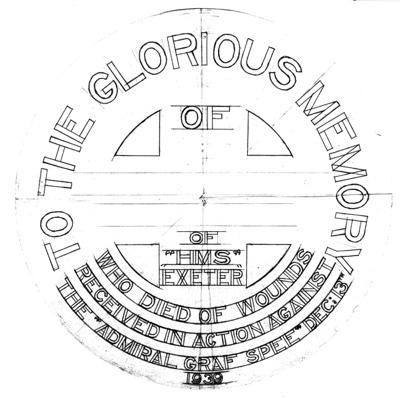
Template for the graves carved by PO Harold Head Pitman.
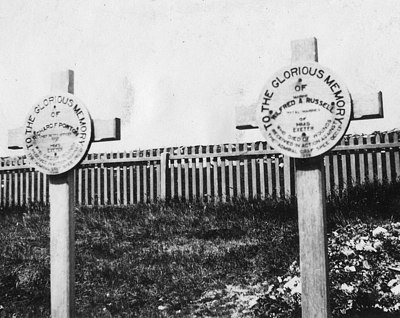
The graves on the Falklands of
Richard F Powton Chief Petty Office Cook,
Marine Wilfred A Russell Royal Marines
PARRY
David John, Telegraphist
PARSONS A W C, Sgt Royal Marines
PARSONS Basil FrancisBasil
Francis Parsons - Petty Officer Stoker was on the ship as part of
the 8th Cruiser Division. After the Battle he was transferred to HMS
Lively and was lost, with the ship in 1942. Submitted by his nephew
John Bronda., Petty Officer Stoker
PAYNE OD,
PEARCE L, Seaman
PEARSALL J K, Lieutenant
PEATE John Henry"My dad
was on the Exeter. He is my hero. Whenever times get difficult I
think of him as a 19 year old gunner on the Exeter during the
battle, wondering if the next moment would be his last. I then think
my troubles are trivial... John Henry ('Jacky') Peate, Able Seaman.
He was very badly injured during the battle as the Exeter took most
of the heat. The decks were make of wood and, with all the shelling,
he had so many splinters in him, his mate Blacky said he looked like
a porcupine. The ship limped to the Falklands Islands, where he
recuperated with the Reid family. Later he and all his surviving
shipmates marched through the City of London and were feted at the
Guildhall, with Winston Churchill in attendance. "Julie Peate
daughter., Able Seaman
PENN-GASKELL Leslie De Nedham WilliamHe ended his
service in the Royal Navy as a Lieutenant Commander. Died in 2010 at
the age of 88. Source: Telegraph, Paymaster
Shipman ¤Mentioned in Despatchess
PETTIT S, Royal Marines
PETT Bryan TExeter and Plymouth Gazette "We heard with
regret the death of Bryan Pett. of Shebbear, who lost his life on
H.M.S. Exeter. He was about 20 years of age, and was well known in
the parish.", Stoker 1
PETT L A, Stoker
PHILLIPS Alfred V, Acting
Leading Seaman - died 14th December
PITMAN Harold HeadHarold
Head Pitman - served on Exeter from December 1936 to February 1940.
He designed and carved the headstones of the four crew buried in the
Falklands. Additional information from his son, John Pitman.,
Petty Officer
POINTON TCS, Lieutenant (E)
POPE C L, Sig
POPE Charles DCPO Charles Pope was the officer in
charge of the sick bay at the battle. The first hit from the Graf
Spee at 06.24 hit to the rear of B gun turret and continued through
the sick bay, with bursting. CPO Pope was knocked unconscious and
the bottles of morphine sulphate which he was carrying were smashed.
London Gazette – Charles D. Pope, Sick Berth Chief Petty Officer;
who, when returning from the fore part of the Sick Bay with bottles
of Morphine Sulphate Solution, was knocked flat and temporarily
unconscious by a shell bursting and badly perforating that end of
the Sick Bay. The bottles were broken, but when he recovered he went
back through the smoke and fumes and not finding more solution
brought back with him Morphia Ampoules. Throughout the action he
displayed great coolness, initiative and cheerful optimism despite
the floods in the Sick Bay. After the action his nursing and
devotion , Sick Berth Chief Petty Officer ¤DSM
POSTLE L,
POWELL H MH M Powell
lived in St Catherine Street, Gloucester. He was greeted by the
Mayor, along with his shipmate J H Keeling, on his return in early
March 1940. BLNA., Able-Seaman
POWTON C
POWTON Richard
FRichard Powton died of his injuries on the 17th December, and
was buried on the Falklands (see photo). From Godolphin Terrace,
Plymouth, he left a widow, an 11 year old daughter and a 6 year old
son. BLNA. Western Morning News "GIFT FROM FRANCE Sent To Stoke Girl
Who Lost Father In H.M.S. Exeter Miss Kathleen Powton, of 18.
Godolphin-terrace. Stoke, whose father died from injuries received
in H.M.S. Exeter, in which he was serving as a chief petty officer
cook, has received a beautiful gift from the French Minister of
Marine, consisting of an attache case containing needlework
materials and also a French doll and a drawing book. An accompanying
note says: " This toy comes to you as your share a gift made through
the French Ministry of Marine from the wives and families of French
sailors to the children of men the Royal Navy and Royal Marines who
have lost their lives in the present war.", Chief Petty
Officer Cook
PRIEST E L, Seaman
PROBERT BenBen Probert was a gunner at the battle. The
Gloucester Journal reported that he was best man at a wedding in
Coleford in March 1940. BLNA., Gunner
PUDDIFOOT George Welch, Sgt Royal Marines ¤ Mentioned in Despatches
PUGH Albert V, CPO
PULLYBANK L W L, Leading Supply
Assistant, D/MX 50647
PULLAR George OliverGeorge joined the HMS Exeter from HMS Rodney on 15 December 1936.
PUNCHARD Edwin GeorgeEdwin
George Punchard was originally from Dartmouth. He was stationed at
the aft control station, essential for steering the ship after the
bridge was damaged., Engine Room Artificer (Stoker)
QUINCY Gordon J,
RAMSDON,
RANDLE FrankStoker PO Randle was aged
41 years old. He lived at Kingston, and left a widow and eight
children between 3 and 18. He had previously served in the Navy for
three years during the First War. BLNA., Stoker PO
RAYMOND Angus KeithAngus Keith Raymond - Leading Air
Fitter (Airframe) Service No FX 75879 Served 24 Aug 1939 to 28 Feb
1940 - submitted by June Goddard (nee Raymond) daughter.,
Leading Airfitter (Airframe)
READ Ernest EdwinErnest
Edwin Read - Marine who joined the ship in August 1939. He was on
the 'B' gun turret during the action. Submitted by his grandsons Ian
Wilson and James Read., Marine
REAGAN, Tel
REAY F, Stoker
REMICK TomBorn in May 1900, Tom Remick joined the Navy in 1915: family tradition has it that his motivation was to avenge the death of his uncle, Jonathan Remick, lost with all hands aboard HMS Monmouth at the Battle of Coronel in November 1914. At the Battle of the River Plate, Tom was on the bridge of HMS Exeter when the forward gun tower was hit, sending shrapnel flying up. This hit the ceiling of the bridge and ricocheted down, killing the men below at the very start of the engagement. He had been on HMS Exeter's cruise around the coasts of North and South America from 1936 to August 1939 and had but four days leave before being recalled to the ship. He had been due to retire in May 1940, and had been engaged by the Royal Canadian Navy to train young signalmen at their training school in Vancouver. Submitted by Liz Broughton, granddaughter., Chief Yeoman of
Signals
RENDLE Charles E,London Gazette – Warrant Shipwright
Charles E. Rendle, Royal Navy; who controlled the shoring up and
general repairs to the after section of the ship during the action.
His untiring energy and great skill in effecting repairs, and so
making the ship watertight after action, were beyond
Warrant Shipwright ¤DSC
RICHARDS Brynmoor, Able Seaman
RICHARDS Glyndwr, Leading Seaman
RICHARDSON A Duncan, Tel
RICHARDSON D A, Pay Sub Lieutenant, Royal Navy Volunteer Reserve
RICKORD John S, Midshipman,
Mentioned in Despatchess
RIGLAR Arthur SamuelTelegraphist
Reglar, who was 20 years old, was the son of Mr and Mrs S Riglar of
West Milton, near Bridport, Dorset. He attended Beaminster Grammar
School and joined the Navy at the age of 15 years. He was a keen
sportsman and had represented the ship at cricket, water polo,
hockey and football. He was also a skilled oarsman. BLNA.,
Telegraphist
ROBERTS Ron MHe was a member of our Taunton Branch
Royal Naval Association early 1980’s and once told me about his
experiences onboard Exeter. He was trapped in a closed compartment
with others when the lights went out and his mates were killed. He
was in the dark compartment with his dead mates for hours before he
was rescued. As a result of his severe injuries Ron was taken back
to Devonport then sent to hospital for a long time, so he missed
Churchill’s visit and the march through London. Submitted by Alick
Lavers, Stoker
ROBERTS, Chief Petty Officer
ROBBINS J,
ROBINS I, Seaman
ROBINSON F, Seaman
ROBINSON S,
ROGERS C, Stoker PO
ROLFE J S, Seaman
ROOKE R,
ROOSKEY Joseph A,London Gazette – Joseph A. Rooskey,
Chief Mechanician (Second Class); whose work was outstanding among
all those on the catapult platforms jettisoning the aircraft. His
calmness, skill and initiative were most valuable and set a splendid
example to Chief Mechanician 2 ¤DSM
ROPE, Musician Royal Marines Band
ROSS A M, Captain Royal Marines
ROTHWELL Victor, Seaman
SALMON,
SAMPSON E, Seaman
SARTAIN, Musician Royal Marines Band
SCANLAN C J, Seaman
SCHOFIELD Harold, Stoker (brother of Norman below)
SCHOFIELD NormanNorman Schofield remained on the
Exeter after her refit, and was one of the few from the River Plate
action to also be on her during the Battle of the Java Sea, when she
was sunk. He survived and was held in a Japanese POW camp for three
years. He returned to England and died in 1999.,
Telegraphist
SCOBLE Clifford J, SBPO ¤ Mentioned in Despatches
SCOOLAR JJ Scoolar was
not on original list. He came from Liverpool.,
Able-Seaman
SCOTT GeorgeJ George
Scott was a forward Gunner during the Battle. He suffered severe
burns when the turret took a direct hit, and became profoundly deaf
after. He was born and lived in Jarrow Tyne and Wear apart from when
at Sea. He died about 2000. , Gunner
SCOTT-KERR JHA, Mentioned in Despatches
SEFTON, Royal Marines
SERCOMBE,
SHANNON Eric, Ck
SHAUGHNESSY PatrickConnacht Tribune 29 January 2015
Baptism of fire
The victims of a terrible Chilean earthquake, an enjoyable time at
the New York World’s Fair, where he was a bodyguard for the King and
Queen of England on the occasion of their visit, and, more recently,
active service in the biggest sea battle fought in the present war,
are some of the experiences of 23-years-old Patrick Shaughnessy, St.
Brendan’s-avenue, Wood Quay, Galway. Mr. Patrick Shaughnessy,
formerly a pupil of St. Brendan’s national school, was a ‘bus
conductor in Galway prior to leaving for England about three years
ago. He is now first-class stoker on H.M.S. Exeter, the 8,000 ton
cruiser which, with the smaller cruisers, Ajax and Achilles,
crippled the 10,000-ton German pocket battleship, Graf Spee, in
mid-December and drove her limping into the port of Montevideo, from
which she steamed a few days later to be scuttled by her own crew.
He visited Galway for a month’s leave last August, but was recalled
after three days owing to the threatening situation in Europe. The
weeks rolled by and war broke out but no news was heard from him.
Then came the story of the battle off Montevideo and his parents
became anxious when it was learned that the Exeter had suffered
heavy damage in the battle. Their fears were, however, allayed
shortly after when his sister, Mrs. J. Glynn, Courthouse Square,
Galway, received a wire from him informing her that he was fit and
well and had received no injury in his first baptism of fire. He is
still with his ship “at an unknown station”. First Class
Stoker
SHAW E, Stoker
SHEFFIELD C, ERA
SHELTON RobertRobert
Shelton - Stoker Shelton was also a Merchant Seaman. Originally on
the unconfirmed list, his place on the ship was verified by his
nephew, Clive Shelton., Stoker
SHOESMITH Eric A,London Gazette – Eric A. Shoesmith,
Acting Leading Airman, F.A.A.; who on his own initiative, despite
his clothing being soaked in petrol, climbed on to the top of the
centre section of the aircraft and cleared the triatic stay which
had fallen across it, thus freeing' the aircraft for jettisoning.
While he did this the ship was under heavy fire, the petrol leaking
from the aircraft was a great danger, and a Turret was firing on a
forward bearing. Acting Leading Airman ¤DSM
SHORTEN J, Cd Gnr
SILCOCKS, PO Ck
SIMMS CEAwarded the
Companion of the Distinguished Service Order. London Gazette
“Commander (E) Charles E. Simms, Royal Navy, H.M.S. Exeter; who, by
his zeal and energy, brought his engines to full power in record
time, and by his thorough knowledge of the ship and perfect
organisation, checked the damage. His calm and cheerful manner set a
fine example to his fellows.”, Cdr ¤DSO
SIMONS A,
SKERRY A E, Royal Marines
SMALL Richard JWestern Times
"HEMYOCK. Sympathy is extended to Mrs. Small. has received of the
death her husband. Blacksmith P. 0.. R. J. Small, on H.M.S. Exeter.
His mother, the widow of ex-P C J Small, resides at Uffculme. He
joined the Navy as a boy in 1917 and has been aboard H.M.S. Exeter
since its commission. ", First Class Blacksmith 3
SMITH Charles JTorpedo Officer Lt. Cdr C. J. Smith
R.N. succeeded, on his own initiative, in passing an order through
to the Lower Conning Position, which resulted in the ship being
brought back on course, while Captain Bell was making his way aft.
London Gazette – Commander Charles J. Smith, Royal Navy; who showed
great calm and resource when communications had failed, in passing
an order for port helm and in firing the starboard tubes at the
correct moment. When required he conned the ship from aft, and after
the action worked tirelessly to repair electrical damage, although
wounded in the leg., Commander (T) ¤DSC
SMITH, John Ernest FM
SMITH George E,London Gazette – George E. Smith,
Plumber, Third Class; who, shortly after the explosion in the Chief
Petty Officers Flat, took a party of Stokers there to free the Main
Switchboard Room's hatch. At the time the flat was in darkness,
reeking with fumes and smoke, full of debris. and with
Plumber 3 ¤DSM
SMITH H, Royal Marines
SMITH Harold EdwardHarold
Edward Smith - was a Gunner and Commander's Writer. His marriage was
postponed in August 1939 when he was recalled to the ship – he
eventually married in February 1940. He died in 1972 and his ashes
were buried at sea from the Commanders Barge, Portsmouth. Submitted
by his son Frank Smith., Gunner
SMITH Joab, Able Seaman
SMITH Stephen,London Gazette – Stephen J. Smith, Petty
Officer; who was in charge of the After Repair Party. A few minutes
after the action opened a shell bursting close to the ship aft
caused the flooding of Number 3 Breaker Room and much damage to the
leads there. His prompt action in running emergency circuits to a
Turret and the after steering motor helped to maintain the ship in
action Petty Officer ¤DSM
SMITH William (Bill), Able Seaman
SOLT W, Stoker PO
SOPER M, Stoker
SPARKS Martin H, Seaman
SPARKS William JohnWilliam Sparks was from Honiton,
and the youngest son of Mr and Mrs F Sparks. He married Miss
Winifred May Meecahm in March 1940. He was a former footballer for
Crewkerne Town. BLNA., Able-Seaman
SPENCER Harry, Able Seaman
SPIERS W R, PO
SPILLER, Corporal Royal Marines
SPLAINE S,
SQUIRE Ernest
BSeventeen year old Ernest Squire was one of two boy buglers
killed on the bridge by shrapnel. He was from Broadhembury, in
Devon, where, on the anniversary of the battle in 1940, an inscribed
clock and photograph was unveiled in his old school. BLNA.,
Boy Bugler
SQUIRES, Horace (Harry)
STABB Douglas Harold, Stoker 2 DKX/92833
STAVERS R,
STEELE Robert M, Stoker Petty
Officer
STONE JohnJohn Stone was
from North Devon. He recovered from his injuries in the Falklands,
before arriving back in the UK in late February 1940. BLNA.,
Signalman
STRIKE Daniel J, Wtr
STUBBS Agean, Marine Royal
Marines
STURDEE ARB, Mentioned in Despatchess
SUMMERLING L F, Steward
SURKITT TrevorTrevor
(Tom) Surkitt - it is claimed he was the youngest member of the crew
at the battle, being just 17. Submitted by Gillian Thwaites, cousin.
When he returned to his home town of Cambridge after the battle, he
was presented with a statuette of a sailor and a sum of money,
raised from donations from members of the public., Gunner
SYMONS Harrold EEvidence that Harold Symons was on the
ship is from several postal envelopes that survive from letters to
his mother.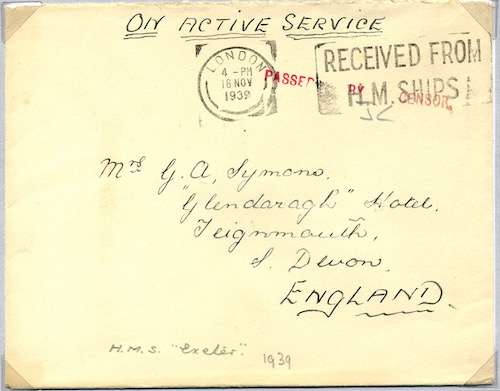 ,
Chief Shipwright New
,
Chief Shipwright New
SWATTEN F, Royal Marines
TAYLOR HarryThis clock was given to Stoker Taylor by
the Crosby Hotel, Scunthorpe, after he returned home after the
battle.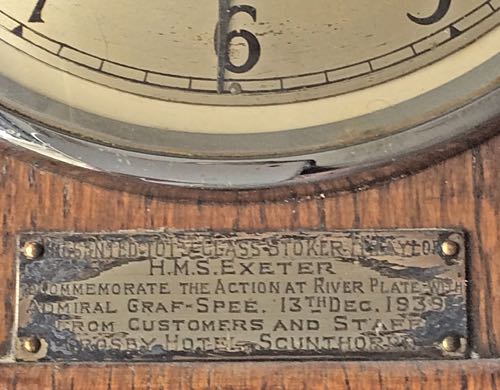 ,
Stoker
,
Stoker
TAYLOR
Robert,
TEAGUE Samuel B P, Chief Petty
Officer Stoker
TELFER, Joe, Petty Officer Gunner
THOMPSON James E, Stoker 1
TILBURY RobertRobert
Tilbury - was wounded at the battle and left the service as a
result. Submitted by his friend Corwin A Bel.
TIMMS W, Canteen
TINDLE L, Stoker
TOASE Aiden ELondon Gazette – Lieutenant Aidan E.
Toase, Royal Marines; who was very active and resourceful in
assisting to render the turret safe after it had been hit by an
11-inch shell., Lieutenant Royal Marines ¤DSC
TOPE I, Seaman
TOVEY George E, Stoker Petty
Officer
TOWELL W, Seaman
TREGIDGO Alfred Frederick FrancisWestern
Times "PLYMOUTH CASUALTIES. A Plymothian who lost his life in H.M.S.
Exeter was Stoker Petty Officer Alfred Frederick Francis Tregidgo,
aged 36, eldest son of Mr. A. and the late Mrs. Tregidgo, of
Brunswick-road, Plymouth. S.P.O. had served two commissions on the
Exeter, and had enjoyed only five days of his leave before being
recalled to his ship at the outbreak of war.", Chief
Petty Officer D/J 89888
TOZER PeterPeter Tozer, Chief Petty Officer, was serving on HMS Exeter and went down with the ship in 1942. His full name is Rupert Peter Tozer but he always went by the name Peter). He was a POW to the Japanese, and was liberated in 1946. He and those captured at the time spent many months in Australia for rehabilitation before being repatriated home.
He has a number of medals, one of which is the Burma Star.,
Chief Petty Officer
TREGARTHEN, Tel
TREGLOYNE T, Musician Royal Marines Band
TREHANE G L, FAA
TRIM, Royal Marines
TROTT BasilBasil Trott was born on 22 December, 1919
in Catford, South East London. He joined the Royal Navy on May 8,
1935 at the age of sixteen and first served on HMS Exeter. At the
time of the Battle, Basil was 19 years old. Basil left the Exeter in
1940 to serve on HMS Kenya. He then served on the Wallace
(1944-1945), HMS Soleby (1946-1948), HMS Comus (1950-1952), and
finally the Whitby (1955-1958). On January 1, 1958 he left the Royal
Navy and pursued a career as a local government officer. Trott Lane
in Ajax, Canada is named after him. Source: Ajax Public Library,
Seaman
TROUT
TRUMAN WPO Truman, was wounded in his right leg and
left eye, and recuperated in South Africa. He was from Exmouth,
Devon. The Western Morning News reported "He was looking fairly well
after his severe ordeal, and showed a representative of "The Western
Morning News" some of the splinters of metal taken from his eye.
Fortunately the eye itself was not pierced, but he has not yet
regained his full sight. His leg has also made good improvement, and
he is able to walk, though with a slight limp. The fight with the
Graf Spec was pretty hot while it lasted, he states. P.O. Truman was
on the bridge at the time as range-finder." BLNA., Petty
Officer
TURNER T W, Seaman
TWEDDELL T, Seaman
TWITCHIN Morris E GTorpedoman
Twitchin was wounded in the River Plate Engagement. After, he served
as “ST” on HMS Bonaventure, in the Mediterranean. He survived
Bonaventure sinking in six minutes after she was torpedoed by the
Italian Submarine Ambra. He was medically retired as “Physically
unfit for Naval service”. Until the end of the war, he was employed
at Pikes Garage, Exeter, where Spitfires were repaired. Service
Number JX 143158, he joined the Royal Navy 6/11/1934 as a Boy Sailor
at HMS Ganges Training Establishment., AB Torpedo
operative
TYE, Sig
TYLER Donald HowardAged 21. Exeter
and Plymouth Gazette "Paymaster Sub-Lieutenant Tyler. FORMER
HEADMASTER'S TRIBUTE. Paymaster Sub-Lieut. Donald Howard Tyler,
killed. H.M.S. Exeter's fight with the Graf was the younger son Mr.
and Mrs. Frank E. Tyler, 52, Polsloe-road, Exeter. Mr. Tyler, sen.,
who has resided in Exeter since 1926, inspector for Lloyds Bank
Limited for the Devon and Cornwall area. Paymaster Sub-Lieut. Tyler
was trained in H.M.S. and was next appointed to the Royal Sovereign.
In December, 1936, he was transferred to H.M.S. Exeter, and left for
foreign service the end of that month... He was educated Exeter
School from September, 1926, to December, 1935, and is described
able boy of fine and manly character. He took a leading part in the
whole life the school, and was a prefect. In 1935 he gained his
Rugby colours, and he was sergeant-major of the Officers' Training
Corps.", Paymaster Sub Lieutenant
VAUGHAN, Musician
VENNING
VINCENT, William
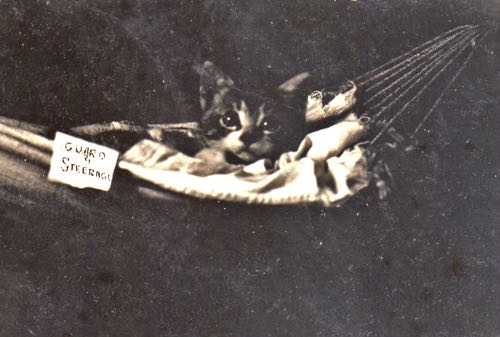
Skeues, the ship's cat. Photo courtesy Dave Eckersall.
WADE W,
WAKEHAM C F, Seaman
WALSH Thomas, Stoker?
WARDER Simeon Henry HarrisSimeon
Warder joined the Royal Navy as a boy, in the 1920s. He remained in
the Navy until the end of the war, ending his service in a shore
posting at a gunnery school. Update details from his nephew Robert
Parry., Leading Seaman
WARREN OD,
WATTS Joseph WestcottLondon
Gazette 23rd February 1940. In Recognition of the gallant and
successful action with the Admiral Graf Spee. Throughout the action
and during the passage to the Falklands C.P.O.S. Watts worked with
efficiency and tirelessly and was of every encouragement to the
wounded. He stayed below decks for a period of 48 hours on end
without thinking of taking a brief respite. He had practically no
sleep, Chief Petty Officer Steward ¤ Mentioned in
Despatches
WAY A,
WEAVER Evan (Ianto),
WEAVER Evan (Ianto)Evan Weaver hailed from the Welsh village of Coychurch. near Bridgend. In May 1940 a concert was arranged by the local Women's Institute in which a presentation was made to Evans for having faught on HMS Exeter in the Battle of the River Plate.
WEEKS E, Stoker
WHITE R B,
WHITING D, Sig
WHITEHEAD A, Seaman
WHITEHEAD C, Seaman
WHITEMORE E, Royal Marines
WICKHAM D T, Lieutenant
WICKHAM K J, Lieutenant (E), Royal Navy Volunteer Reserve
WILDE Arthur B, SergeantLondon Gazette – Arthur B.
Wilde, Sergeant,. Plymouth; who ordering the evacuation of a Turret
after the Gun House had been hit by an eleven-inch shell, calmly put
a tourniquet of rope round the stump of a Marine's arm. He then
returned to the Gun House where he found a fire over the rammer of
the left gun. This rammer contained a charge of cordite. He
organised a chain system of buckets to the turret, put out the fire,
removed the cordite, and threw the charge over the side.
Royal Marines ¤DSM
WILKINS L W, Seaman
WILLIAMS E,
WILLIAMS J D, Sig
WILSON E, FAA
WILSON Patrick, Stoker 1
WINSTANLEY F,
WINTER, ERA
WRIGHT WilliamPhillip
Wright wrote of his father "My late father William Wright (Stoker)
served on HMS Exeter at the Battle of the River Plate. I also have a
very large photo of all the ship's crew with Commodore Harwood but
not sure of the year. I also have a silver football medal when HMS
Exeter won a footbal inter ship final.", Stoker
WOOD James Stanley, Petty Officer
WOODS Humphrey Ropner Duncan,
Captain Royal Marines
WOODS WilliamWilliam
Woods married in February 1940. His rank is unknown. BLNA
WOODWARD Griffith George, CERA ¤Mentioned in Despatches
YOUNG
The following names are of those who served in Exeter during the commission December 1936 - August 1939, but have not been confirmed as members of the crew during the battle.

ARBERRY, Seaman
BLACKBURN, Boy
ELSTON, L Stoker
FAULKNER, Seaman
GILL, Stoker
HICKS, LSA
HIGMAN, OA
HOCKINGS, Seaman
LANGUARD, Leading Stoker
LOVESAY, Leading Steward
LOWTHER, Stoker PO
LUKEHURST, RM
MOORCROFT, Leading Seaman
MORGAN, Leading Stoker
MOUNTJOY, Leading Stoker
NORTHEY, Stokerr at HMS Drake. He was killed
PICKERING, Stoker
ROBINS, Petty Officer
SOADY, Stoker
EMMOTT, J Able Seaman
FLEMING, J P, Able Seaman
HAYES, F W, Petty Officer
RAVENSCROFT, J T, Stoker PO
ROBERTS, LF, Able Seaman
WILSON, G B, Leading Seaman
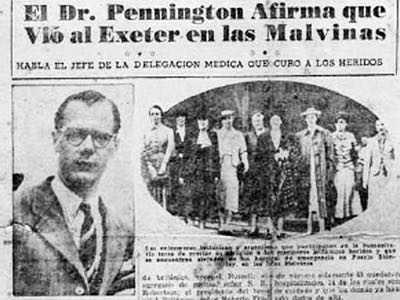
Dr Pennington and the nurses who went to the Falklands
to treat the injured from HMS Exeter.
Supplied by Alejandro Miles Stuart Pennington
British Hospital, Buenos Aires nurses led by Dr M J Petty, who were taken to the Falklands on SS Lafonia to look after the wounded. See Falkland Nurse's Account.
Mrs. I. Watson, Miss Potts. Miss Elder. Miss Ford, Miss Reid, Miss Shaw, Miss McGreave. Miss Sutton, Miss Sandleir, Miss Robson-Smith, Miss Haines, and Miss Mallas.
Dr Pennington, a radiologist from Buenes Aires accompanied the nurses on SS Lafonia. He was awarded the OBE by King George VI for his services to the injured.
At the time of the battle, HMS Exeter had two ships mascots, one of which survived.
│ Top of Page │
